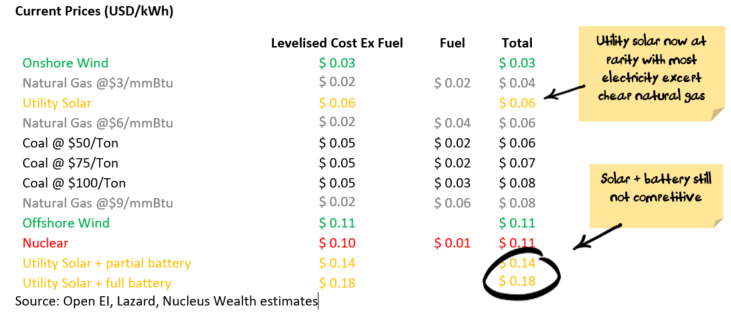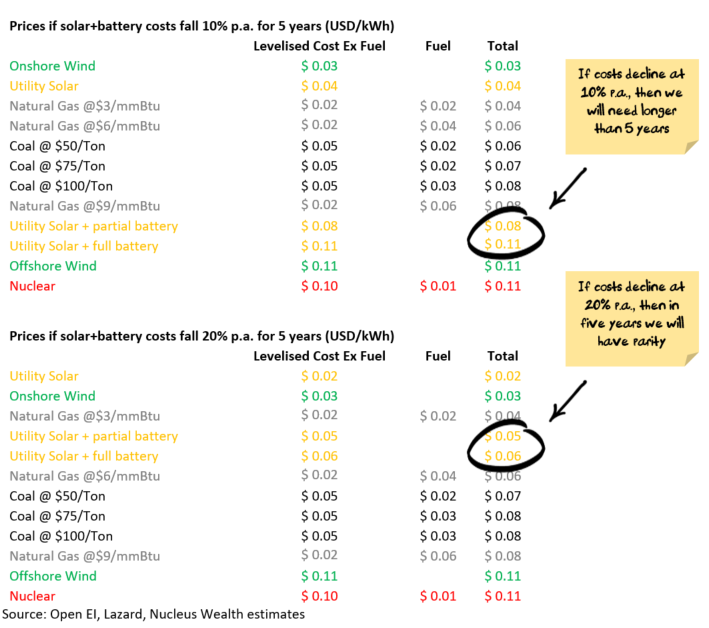Poor old Do-coal Malcolm is neither Arthur nor Martha, via AFR:
Prime Minister Malcolm Turnbull has mounted a defence of coal-powered electricity, saying those who think the resource doesn’t have a future are “delusional”.
Addressing the Liberal National Party state convention in Brisbane, Mr Turnbull hit out at the state Labor government’s “reckless” plans to ensure Queensland’s energy supply is carbon neutral by 2050 and said Australia had an interest in ensuring the future of coal.
“Those people who say coal and other fossil fuels have no future are delusional and they fly in the face of all of the economic forecasts,” he told the crowd of party faithful.
His sentiments were greeted with applause by the crowd, who had a day earlier passed a resolution urging a future state LNP government to promote and support the coal industry.
He went on, via AAP:
The convention is also considering a resolution to call on the Turnbull government to withdraw from the Paris Climate Accord, which is likely to be debated on Sunday.
Mr Turnbull devoted a significant portion of his 20-minute address to energy policy, warning of the impact of renewables on power prices and the security of the electricity grid.
He said Queensland’s efforts to source 50 per cent of its electricity supply by 2030 would see it follow the path of South Australia, which has been hit by high prices and supply issues.
“We know what happens if you allow left-wing ideology and politics to drive your energy policy. You get unreliable and unaffordable power, and business is driven out of your State,” he told the crowd.
“Now, what the Palaszczuk government is seeking to do here is undermine your competitiveness in the interests of chasing green votes in the inner city and you can’t allow them to get away with it, and we won’t.” He said as the world’s largest exporter of coal, Australia had an interest in demonstrating that clean-coal could play a role in a low-emissions energy future.
Mr Turnbull later told reporters ideology had no role to play in the energy policy debate.
“The critical thing to do with energy is to plan it, you’ve got to be businesslike about it,” he told reporters on the Gold Coast. “That’s why I say our policy is based on engineering and economics, not on ideology and politics.”
What policy? Turnbull’s Finkel Report isn’t a policy, it’s a report. Even it says coal is doomed.
The answer to the question “does coal have a future” depends upon how you define the word “future”. If you see it in geological time then it does not. If you see it as a few decades, yes, coal has a future. If you see it as any longer than that then you’re as extinct as the dinosaurs that make up the coal.
The answer to the question is now out of the hands of policy. Economics is the key driver and it is unequivocal that coal has no future beyond a few decades. Here are the current prices for electricity generation:

Utility Solar at 6c is now in front of coal, and in front of natural gas at Australian and Asian prices. Natural gas is still cheaper in the US.
The battery prices shown here are for shifting solar in particular. This is not the same as the current energy crisis in South Australia – that is a matter of smoothing intermittent sources and has different economics. Gas peaking plants (which are used for intermittent power) run at about $0.20-$0.30 per kWh and the battery costs above would be higher for intermittent use. Most recent large-scale studies have shown that batteries are cost effective for the grid at the margin to smooth the peaks and troughs, but not for widespread adoption. The 100-day Tesla batteries would have the same profile.
But, here is the MB’s outlook for five years:

If battery and solar manufacturing prices keep falling 20% per annum, slower than their current rate, then they will be cheaper than coal at utility scale within five years. That’s your killer app for renewables with base load and intermittency questions answered.
Coal and gas will not cease to be used when we hit parity, it is just that the price will be limited to no more than solar plus batteries, and that cost will fall year after year. Any investment in these companies should be done with falling commodity price expectations – i.e. value them in run-off. There may be short-term shortages/price spikes, but these are selling opportunities.
For a Liberal Party with a supposed nose for business it is pretty stupid yoking itself to a rapidly dying business model.
Why does it do it then, I hear you ask? Well, one reason is it is paid to. Another is its troglodyte ideology. But most important is politics, back to Turnbull:
“We know what happens if you allow left-wing ideology and politics to drive your energy policy. You get unreliable and unaffordable power, and business is driven out of your State,” he told the crowd.
“Now, what the Palaszczuk government is seeking to do here is undermine your competitiveness in the interests of chasing green votes in the inner city and you can’t allow them to get away with it, and we won’t.” He said as the world’s largest exporter of coal, Australia had an interest in demonstrating that clean-coal could play a role in a low-emissions energy future.
There is a major reason why this speech is happening in QLD. Malcolm is chasing One Nation votes, the heartland of which sits right on top of Australia’s largest coal basins where unemployment is high. Both he and the the Palaszczuk government are already busily spending taxpayer dough on coal pork for Adani and, next it seems, will be a few publicly-owned coal power stations for the region.
That’s the thing, you see. The energy paradigm has inverted, public subsidy has shifted from supporting renewables to giving coal a future. To wit, via The Guardian:
Conservation groups registered as eligible for tax deductible donations, as they do every year. But this year the correspondence is different, in a disturbing way.
In the past the groups, which include all the big names such as the Australian Conservation Society, The Wilderness Society, Lock the Gate, Greenpeace etc, as well as small local conservation organisations, were simply asked to reveal the total expenditure from their public fund. This year they have also been asked to break down their expenditure into the amounts spent on “on ground environmental remediation”, “campaign and advocacy”, “research” and other administration.
It sounds like a boring technicality but it seems to represent a significant victory in the long-running campaign by the mining industry and conservative politicians to hobble advocacy for the environment.
Coal has a future as it is wound down into the great renewable transformation. And as a giant succubus at the public teat.
Exactly who is delusional here?

